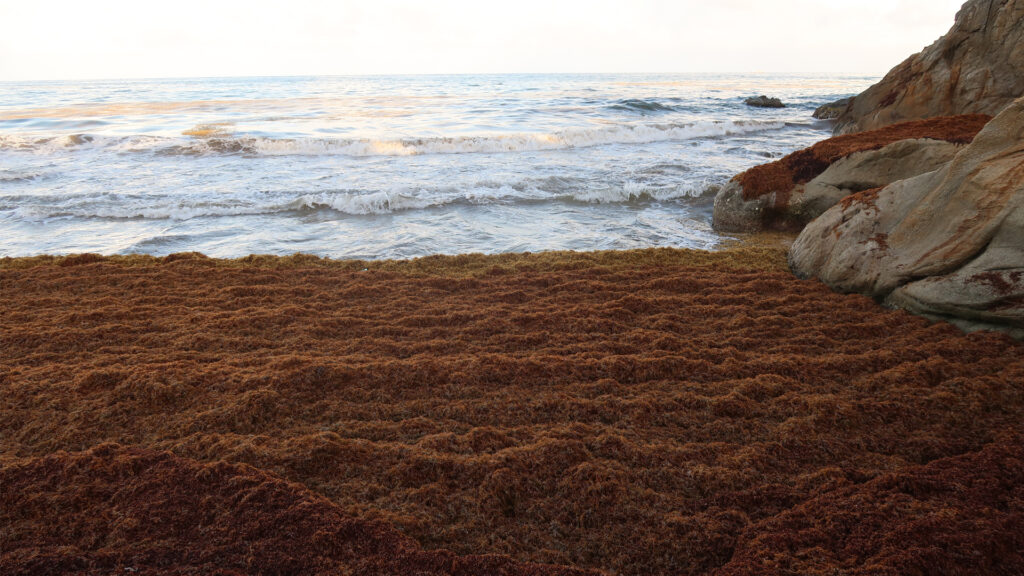By Robert C. Jones Jr., University of Miami News
Beachgoers see only the final act: thousands of pounds of brown macroalgae decomposing on shorelines and emitting an odor that smells like rotten eggs.
What they miss is the journey that leads to Sargassum seaweed’s seasonal sojourn on Caribbean and South Florida coastlines. It’s an ocean voyage that starts in an area of the Atlantic between West Africa and the Gulf of Mexico. And all kinds of factors — from meandering currents to stiff winds and even biology — can determine where and when the stuff comes ashore.
Now, a team of University of Miami physical oceanographers, using a 49-foot-long air-sea interaction saltwater tank (ASIST), has determined how much of a role winds, water and currents play in moving Sargassum through the ocean.
Their results, obtained after three days of controlled experiments followed by hundreds of hours of analysis, are the first step toward creating a mathematical model to predict Sargassum’s arrival on Caribbean and Florida beaches, where unusually large clumps of the seaweed have washed ashore every summer during the past 12 years.
“Modeling the path of anything that floats in the ocean — whether it’s seaweed, trash or oil — requires us to consider a host of factors, with all sorts of factors coming into play,” said Maria Josefina Olascoaga, a professor of ocean sciences at the Rosenstiel School of Marine, Atmospheric, and Earth Science. “Wind is one of those factors, along with ocean currents. But finding out how significant a role wind plays in transporting Sargassum has always been a challenge, and that’s where our study comes in.”

Subjecting samples of Sargassum seaweed to different environmental conditions in ASIST, she and her team discovered that wind and ocean currents combine to move large clumps of seaweed around the ocean, with the wind contributing to a smaller degree than they initially believed. “The windage is slightly smaller than 1%, yet that is critical to bring Sargassum into the Caribbean Sea along with the drift induced by the waves,” Olascoaga said.
Their study is the first to directly measure the windage of Sargassum under controlled conditions. “Given the wide range of windage values used in modeling Sargassum transport, and the potential uncertainty this introduces in predictions, direct measurements of wind effects on Sargassum movement are of considerable importance for predicting its movement and forecasting beaching events,” the researchers wrote.
Using the results of their controlled experiments in ASIST, the researchers are developing a model to simulate the motion of Sargassum seaweed in the North Atlantic, specifically in and around the Caribbean Sea, Gulf of Mexico and South Florida. That model is now in its final stages of development, and the researchers have deployed specially made drifters in large seaweed mats at sea to test its effectiveness.
“What makes our model unique is that it is the first of its kind to simulate Sargassum mechanistically — that is, by treating Sargassum as something that obeys specific physical laws from fluid mechanics — while also including biological effects,” said Gage Bonner, a postdoctoral associate and member of Rosenstiel’s Nonlinear Dynamics Laboratory which is spearheaded by Olascoaga and Francisco Javier Beron-Vera, a research associate professor of atmospheric sciences.
“The idea is that a large raft of Sargassum is modeled as a network of smaller clumps, which ‘feel’ ocean currents and winds and simultaneously interact with each other in the same way that clumps of the real seaweed would,” Bonner explained. “They can group together to form larger rafts, fracture apart to make smaller rafts and beach when reaching the shore. They can even grow and die according to things like the temperature of the water and availability of nutrients.”
The researchers are calibrating their model against satellite imagery of Sargassum to ensure its accuracy, and they plan to conduct more experiments in ASIST, this time to study the impact of waves on the transport of Sargassum.
The model, they hope, will vastly improve the forecasting of Sargassum beaching events, allowing local municipalities to prepare for the seaweed’s impacts well in advance.
Every year since 2011, the free-floating seaweed has inundated Caribbean, Gulf of Mexico and Florida coastlines during the hot summer months, emitting toxic fumes and wreaking havoc on coastal ecosystems as it decays.
The mathematical model will be soft launched to coincide with a forthcoming journal article on the researchers’ National Science Foundation-funded study, with 2024 the target year for its full use. “We’ll want to evaluate its effectiveness and get feedback from the scientific community before widely distributing it as a full product,” Bonner said.
The study of ocean transport is just as critical as hurricane forecasting, said Olascoaga, who conducted extensive research on the movement of oil in the Gulf of Mexico after the Deepwater Horizon spill.
“From an oil spill to search and rescue operations, and from the study of heat transport for climate change problems to investigating larvae transport, learning more about the transport and mixing properties of the ocean is vital,” she said.
This piece was originally published at https://news.miami.edu/stories/2023/10/tracking-the-stinky-stuff.html
Sign up for The Invading Sea newsletter by visiting here. If you are interested in submitting an opinion piece to The Invading Sea, email Editor Nathan Crabbe at ncrabbe@fau.edu.



